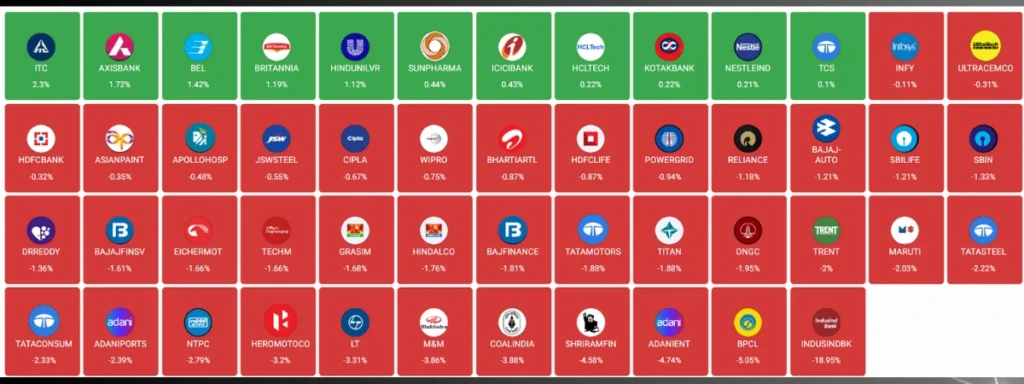The Indian equity markets extended their recent downward trend today, as disappointing earnings reports from several major players and foreign institutional selling fueled a fifth consecutive day of losses.
The benchmark indices, Sensex and Nifty, fell sharply, with the Sensex closing down by 663 points (0.83%) at 79,402, and the Nifty losing 218 points (0.9%) to close at 24,180.
This Wiped out approximately ₹6 lakh crore in market capitalization, leading analysts and investors to ask, what’s next?
Breaking Down the Decline: Key Drivers and Sector Impact
Today’s selloff was driven primarily by weak quarterly earnings and substantial outflows from foreign investors, who have been consistently offloading Indian equities.
IndusInd Bank, one of the hardest-hit stocks, fell nearly 20% in a single day in response to its poor Q2 performance, which spooked investors and set the tone for the market.
Foreign Institutional Investors (FIIs):
Foreign Institutional Investors (FIIs) have been steadily moving funds out of Indian stocks in favor of other markets, particularly China.
China has seen stimulus measures aimed at boosting economic recovery, offering comparatively attractive valuations that draw global attention.
This month alone, FIIs pulled out approximately ₹98,000 crore from Indian markets, underscoring the impact of global shifts on domestic equities.
U.S. Bond Yields and Dollar Strength:
Rising U.S. bond yields, now above 4%, along with a strong dollar, have increased the appeal of U.S. assets, reducing the attractiveness of Indian investments.
Higher yields often prompt investors to shift their money back to the U.S. or other safe-haven markets, particularly in times of global uncertainty.
Sector Analysis

The selloff affected almost all sectors, with Nifty Auto, Metal, and Consumer Durables seeing some of the largest losses. Here’s a breakdown of how specific sectors were impacted and what investors might anticipate going forward:
- Financials: IndusInd Bank, HDFC Bank, and State Bank of India led declines in the financial sector. Rising asset quality concerns are pressuring banks, and unless Q3 earnings signal improvement, financial stocks may remain volatile.
- Autos: The auto sector experienced significant declines, with stocks like Mahindra & Mahindra and Tata Motors hit by slowing sales and cautious demand projections for the festive season. However, as consumer spending gradually picks up, this sector may offer long-term value opportunities, especially among electric vehicle (EV) players.
- Consumer Goods: Even typically stable FMCG companies like Nestlé and HUL saw a dip, largely due to weaker rural demand. However, consumer staples are often resilient in downturns, and this dip could present entry points for long-term investors.
- IT: Amid the broader slump, IT stocks showed relative stability. Demand recovery in key overseas markets, especially the U.S., alongside strong earnings from global firms, may bolster this sector, presenting a potential safe haven for investors seeking lower-risk exposure.
Long-Term Outlook and Opportunities
While the current downtrend has led to short-term losses, market corrections also often reveal new opportunities. Long-term investors may want to consider sectors showing resilience and potential for recovery, especially as earnings season progresses and we gain greater clarity on which companies are better positioned for the evolving economic landscape.
Emerging Risks and Near-Term Uncertainty
Investors should remain cautious as global factors continue to weigh heavily on Indian markets. Here are some key considerations for the coming weeks:
- Global Tensions and Economic Data: Heightened geopolitical tensions, such as those in the Middle East, and the outcome of the U.S. elections will likely contribute to market volatility. Additionally, inflationary policies in the U.S. could impact Indian firms reliant on imported goods, as a strong dollar may drive up costs.
- Interest Rates: The likelihood of significant U.S. rate cuts appears slim, a shift from prior expectations. Markets are now pricing in only a modest probability of a 25-basis-point cut in November. Indian companies that are highly leveraged could feel the pressure of prolonged high rates globally.
- Foreign Fund Flows: FII behavior remains a crucial factor, and signs of stability or reversal in outflows could improve sentiment. However, given the recent selloff, FIIs may only return if valuations become more attractive, or if Indian companies surprise with better-than-expected earnings.
Also, read | Global Economic Challenges: Navigating High Debt and Slowing Growth
Bottom Line
While the Indian stock market’s near-term outlook remains uncertain, investors can still find value by focusing on fundamentals and sectors likely to weather the storm.
Defensive sectors like FMCG and healthcare, along with resilient IT stocks, may offer stability, while those with a longer horizon could look into sectors such as autos and financials once earnings visibility improves.
Market corrections often provide strategic entry points, and a diversified approach can help investors manage risks amid this volatility.



